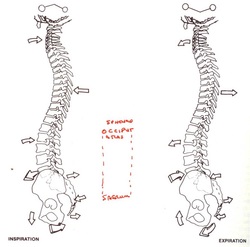In recent writings I have talked about hip pain and from the response I received there seems to be an epidemic of this problem. In the last article I wrote about the necessity of the ankle joint and its use to reduce pressure on the hip region. I have talked how the knee joint acts as the turnbuckle joint. That allows the ankle to accomodate any oddities that the foot encounters and minimizes stress to the hip joint. One area that is often overlooked but is critical in the assessment for Muscle Release Therapy, MRTh® is the lower thoracic and lumbar paraspinals. The lower thoracic is directly related to the Gluteus Medius, while the lumbar paraspinals to the short head of the Biceps Femoris of the Hamstring muscle group. This interaction of the tensegrity of the skeleton is crtical to resolving issues of the hip joint and also to help reverse some of the unnatural tension on the lower veretbrae.
The verebral column consists of the most articulations in the skeleton, therefore it has the most range of motion of any portion of the skelton. This fact is often overlooked when someone has a complaint such as hip or knee pain, plantar fascitis, or a penchant for turning their ankle. When the interconnection of the vertebral column and the lower extremity is in an unnatural tension there is an adaptive quality that needs to happen to allow movement to take place. It is important to remember that the brain will do what is necessary to protect the integrity of its lifeline, the spine. This is the most intrical part of the anatomy as it carries the nerve energy needed to move.
So how does the spine play into hip joint pain? I wish the answer was an easy explanation but I will do my best to simplfy it for all of us. This picture show the movement of the spine during inspiration and expiration.

The above action will now force the lumbar spine to over compensate for the reduced movement of the verebrae above it. This will alter the Sacrum (large tailbone) and will cause many issues with that joint and one of the side effects is Sciatic nerve discomfort. That is how the short head of the Hamstring muscle becomes involved.
This sets up trigger points in the muscles and forces fibers to move in different formats to avoid discomfort. These trigger points, often thought of as acupressure points, will interfere with the normal nerve transmissions and interrupt proper sensory to motor movement. When trigger points are imbedded in the muscle fiber the fiber's ability to function is inhibited and normally this is when the action potential, or the fibers ability to fully contract, is limited. Muscle Release Therapy, MRTh® premise is to locate these areas, assist the brain in relieving and balancing the proper tension to bring about a natural tension to the skeleton.
Fundamental Movement Therapy(SM) helps the brain re-program proper movement and helps to re-inforce the neurological activity between the ligaments, tendons, and muscles.
In my next blog, I will continue to investigate the movement of the spine in relationship to lower leg, hip, knee and ankle discomfort and dysfunction. So, next time you have hip pain make sure the interconnection of the movement in the spine is balanced to the tension of the lower extremity skeleton.
If you have questions, or would like a free consultation, please call 216-364-0152 or email us at [email protected]. One of our therapists or instructors will be glad to discuss how we might be able to help.
Happy 2012 and there is...a Reason to HOPE!
Dennis
 RSS Feed
RSS Feed
